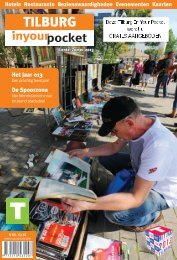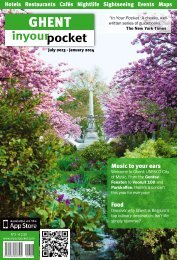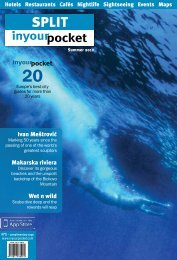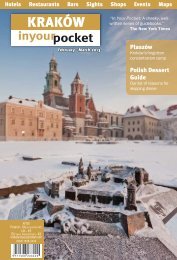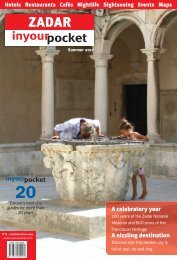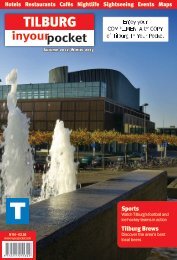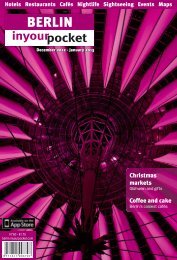7kh 7ul flw\ v prvw dxwkhqwlf 7h[ 0h[ uhvwdxudqw ... - In Your Pocket
7kh 7ul flw\ v prvw dxwkhqwlf 7h[ 0h[ uhvwdxudqw ... - In Your Pocket
7kh 7ul flw\ v prvw dxwkhqwlf 7h[ 0h[ uhvwdxudqw ... - In Your Pocket
You also want an ePaper? Increase the reach of your titles
YUMPU automatically turns print PDFs into web optimized ePapers that Google loves.
78<br />
STUTTHOF STUTTHOF<br />
Kommandatur... SS staff building<br />
Long before the outbreak of war Nazi officials in the Free City<br />
of Danzig had been conspiring to build a camp designed to<br />
detain and ultimately exterminate ‘undesirable elements’ of<br />
the local population. <strong>In</strong>deed, as early as 1935 lists detailing<br />
the names of Polish politicians, intellectuals, economists,<br />
religious figures and patriots were compiled by the German<br />
Schutzpolizei. As covert preparations for war intensified<br />
Himmler himself visited Danzig twice in the summer of 1939,<br />
giving orders for the immediate strengthening of the local<br />
police force. Furthermore August saw Gdańsk jail emptied,<br />
the Victoriaschule (a girls school B-5 ul. Kładki 1) adapted to<br />
hold large numbers of prisoners, and Sutthof identified as the<br />
site of a camp. All the components, so it would seem, were in<br />
place to wage a decisive strike against the sections of Polish<br />
society most likely to disrupt the Nazi vision of the future.<br />
September 1, 1939, not only signalled the invasion of Poland,<br />
but also the beginning of a Saubersungsaktion (cleaning action)<br />
by the police force. Waves of mass arrests followed, with the first<br />
batch of prisoners arriving in Stutthof the following day. Stutthof,<br />
penned in by sea and forest, but also serviced by rail lines, was<br />
seen as an ideal location for a camp, and by February, 1940,<br />
it had emerged as the principal holding area in Pomerania for<br />
enemies of the Nazi state. At this stage, however, it was still<br />
classified as a civilian camp, and it wasn’t until an official visit<br />
from Himmler in November 1941 that it was transferred to the<br />
jurisdiction of the Concentration Camp <strong>In</strong>spectorate. What had<br />
started off as a relatively small camp now welcomed transports<br />
from across conquered Europe; by the end of the war Stutthof<br />
had grown to include 26 sub-camps covering an area of 120<br />
hectares, and holding an estimated 57,000 inmates.<br />
Conditions were brutal with hard labour, epidemics and<br />
starvation all culling prisoner numbers. Furthermore, those<br />
who fell sick could expect to be murdered with a phenol<br />
Stutthof medical wing<br />
injection to the heart delivered by one of the camp doctors.<br />
The second half of 1944 saw the decision to transport<br />
Jews to Stutthof, a move that led to the killing process being<br />
streamlined further with the addition of a gas chamber and<br />
crematorium; of the 50,000 Jews imprisoned in Stutthof only<br />
3,000 are estimated to have survived.<br />
With the Red Army approaching, and liberation in sight, the<br />
Nazis played the final card in their heinous game. An earlier<br />
decree issued by Himmler had insisted no prisoners be liberated,<br />
and as such tens of thousands were forced on arduous<br />
‘death marches’ to camps further west. Scores perished on<br />
the way, with those unable to continue summarily shot and<br />
killed on the roadside. Soviet troops finally entered the camp<br />
on May 9, 1945, greeted by little more than 100 emaciated<br />
inmates who had managed to hide during the evacuation<br />
process. Latest research indicates that of the 100,000<br />
prisoners incarcerated throughout Stutthof’s existence, only<br />
a third of that number survived.<br />
The search for justice began immediately with the first Stutthof<br />
trial concluding in June, 1946. Eleven death sentences<br />
were passed, and these were carried out a month later in<br />
front of a baying crowd of over 200,000 on J-4 ul. Pohulanka<br />
in the Biskupia Góra district of Gdańsk. However, no commandant<br />
was ever brought to face a Polish court; Max Pauly<br />
was executed by the British for crimes in Neuengamme,<br />
while the second commandant, Paul Werner Hoppe, was<br />
only arrested years later in 1955. The man behind the<br />
Stutthof death marches was eventually tried in the west<br />
before receiving a sentence of nine years. Doctor Otto Heidl,<br />
involved in countless phenol injections, cheated justice by<br />
committing suicide in prison. The cases of over 1,900 SS<br />
men and women employed at Stutthof never came to court.<br />
Getting There<br />
The town of Sztutowo lies 55 kilometres east of Gdańsk and<br />
is easily accessed by both car and bus. Journey time by bus<br />
us about 80 minutes and cost 14.00 zloty at time of writing.<br />
From Gdansk bus station board the bus headed to Krynica<br />
Morska, then jump off once you pass the perimeter of the<br />
camp on your left hand side.<br />
By car There are three routes you can follow, the first of<br />
which is 40 kilometres. Take road number 501 until it reaches<br />
Świbno. From here take the ferry crossing (cars 14zł, foot<br />
passengers 4zł), and from there follow the signs. This scenic<br />
route is only possible from the end of April to October 20,<br />
and it’s also closed in bad weather.<br />
Alternatively take road number 7 before going left just after<br />
crossing the Wisła (in the direction of Mikoszewo). Once in<br />
Mikoszewo follow signs to Krynica Morska. You’ll find Sztutowo<br />
on the way. Total distance - - 55km.<br />
Finally, you could take road number 7 (Gdańsk-Warszawa),<br />
before switching to road number 502 at Nowy Dwor<br />
Gdanski. Then follow signs to Stegna, then Sztutowo. Total<br />
distance - 65km.<br />
Entrance to the museum is free as is parking until May.<br />
Muzeum Stutthof w Sztutowie ul. Muzealna 6, Sztutowo,<br />
tel. (+48) 798 41 80 24, www.stutthof.org. <strong>In</strong> the<br />
years after the war Stutthof was allowed to fall into disrepair,<br />
many of its buildings falling prey to both the elements and<br />
looters. The Kommandatur building at the front - once the<br />
administrative heart of the concentration camp - existed for<br />
over a decade as a tourist hotel, while the former DAW Armaments<br />
Factory passed into state hands. The decision to turn<br />
Stutthof into a museum was only reached in 1961, and what<br />
you see today is the result of years of research and restoration.<br />
Covering around 20% of the former camp area, Stutthof<br />
Gdańsk <strong>In</strong> <strong>Your</strong> <strong>Pocket</strong> gdansk.inyourpocket.com<br />
Museum has undergone a significant program of progress<br />
to allow non-Polish visitors the chance to understand what<br />
happened here: English language signs, walking trails and<br />
explanation boards - for so long mono-lingual - have been<br />
added, while in the car park a small booth sells books, guides<br />
and memorial candles - this might be getting knocked down<br />
soon, so head instead to the year-round store inside the main<br />
museum building. To fully appreciate the history of Stutthof<br />
purchase Janina Grabowska-Chałka’s excellent guide book<br />
for 25zł, or one of the new small printed guides available in<br />
Polish, English and German for 4zł.<br />
Walking from the car park visitors should follow the path to<br />
the main gates. Tour guides are available from the former<br />
SS guardhouse to the left, while sobering films detailing<br />
everyday life in the camp are shown in the Kommandatur<br />
further on. Screenings are shown every half hour (minimum<br />
of four people necessary, with the last screening at 17:30),<br />
and the films act as a fitting prelude to what you are about<br />
to see. It’s also here, in corridors that once resounded to<br />
the thump of jackboots, you’ll find temporary exhibitions of<br />
inmate art as well as the archive and book of remembrance<br />
(which is on display variously depending on exhibits).<br />
Having left the admin building the scale of atrocities hits<br />
home on entering the first proper exhibit: thousands of<br />
shoes confiscated from prisoners lie piled up in dusty stacks,<br />
presenting visitors with a stark, grim image that takes a long<br />
time to dispel. It’s after this visitors pass through what was<br />
once referred to as ‘the death gate’ - the main entrance<br />
through which tens of thousands entered the camp. Directly<br />
to the right a hot and musty barracks tells the wartime history<br />
of both the camp and the regime. The outbreak of the war<br />
is covered in specific detail, with accompanying photos and<br />
mugshots of the first arrests and Nazi murders, while further<br />
on other sections deal with the camps construction and the<br />
SS crews employed within; Himmler’s visit is given particular<br />
attention, as are the roles played out by his underlings in<br />
Stutthof - on show a commemorative goblet presented to<br />
the first commandant, Max Pauly, by his colleagues.<br />
Just how fast Stutthof swelled and increased in size is illustrated<br />
next, as well as individual stories of heroism and<br />
escape; only Wlodzimierz Steyer is recognized as having<br />
successfully fled, testament enough to the camps reputation<br />
as being escape proof. A huge scale model, hidden behind<br />
glass, demonstrates the size of the challenge prisoners<br />
would have faced while planning such break-outs.<br />
From here visitors cross the grass to reach the barracks that<br />
formerly housed the women’s block. English explanations<br />
decrease in frequency at this stage, though the maps showing<br />
prisoner transports, striped uniforms and photographs<br />
of gaunt looking prisoners prove self-explanatory enough.<br />
Most poignant of all, a host of personal items are also on<br />
display. These include rings crafted illegally by prisoners,<br />
gdansk.inyourpocket.com<br />
Crematorium<br />
dolls and pictures drawn by children - lollipop trees et al. It’s<br />
powerful stuff, and the experience gains further significance<br />
as you shuffle across creaking wooden floors. One barrack<br />
is stacked solid with original triple tier bunks, while others<br />
are home to a brutal looking operating theatre as well as a<br />
slab on which prisoners would lie before being given a fatal<br />
injection of phenol. The sight of clunky looking syringes<br />
repulses the body.<br />
As the war lengthened the killing process was streamlined,<br />
and next on your tour is a brick gas chamber used to execute<br />
anything up to a hundred prisoners at a time. A Star of David<br />
and Catholic cross outside recognizes the beliefs of those<br />
who died, while to the right is a gloomy crematorium used<br />
to burn corpses. Three original ovens have been preserved,<br />
and these are flanked by memorial notices, candles and<br />
floral tributes. Walk through further chambers outlining the<br />
Nazis’ murderous methods, as well as rooms dedicated to<br />
the death marches and the Nazi trials that followed after. An<br />
original gallows stands outside, as well as cattle trucks used<br />
to transport men and women from across occupied Europe.<br />
As you loop around to the area of the ‘new camp’ your route<br />
takes you past an epic memorial that dominates the skyline.<br />
Known as the Monument to Fight and Freedom, and designed<br />
by Wiktor Tolkin, it was unveiled on May 9, 1968, the 23rd<br />
anniversary of the camps liberation. Forming a part of this<br />
landmark obelisk is a horizontal shaped reliquary containing<br />
the human ashes and bone fragments recovered from the soil<br />
in the excavations that followed in the years after liberation.<br />
Remembrance services are held here on the first Saturday<br />
of September to mark the creation of the camp.<br />
Much of Stutthof was razed to the ground as the Nazis<br />
sought to hide traces of their crimes, and as such the area<br />
known as ‘new camp’ now has 21 concrete blocks placed<br />
in the area where the barracks once were, as well as a Star<br />
of David marking what was once the Jewish area of the<br />
camp. Walking across this wind blasted field allows plenty<br />
of opportunity for reflection, though don’t think your visit has<br />
ended. Around 500 metres into the forest to the north of the<br />
perimeter is what is referred to as ‘the Holocaust stake’.<br />
Prior to the construction of the gas chamber it’s here that<br />
thousands of Jews were herded before being executed by<br />
firing squads, their bodies then burned on funeral pyres. A<br />
ring of symbolic stones marks the edge of the pit. QOpen<br />
09:00 - 18:00. Admission free (contributions welcomed). Film<br />
exhibit 3zł. Guided tours 140zł. Audioguides 15zł. Children<br />
under 13 should not visit the museum.<br />
Stutthof gas chamber<br />
May - July 2012<br />
79




